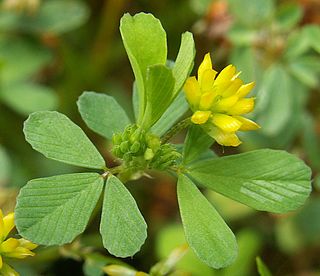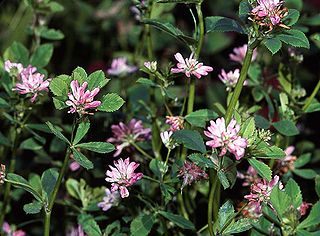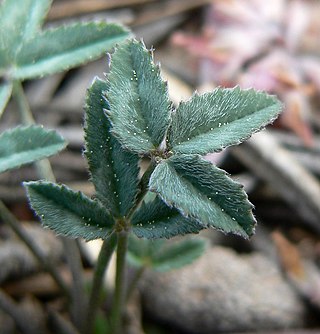
Trifolium pratense, red clover, is a herbaceous species of flowering plant in the bean family Fabaceae, native to Europe, Western Asia, and northwest Africa, but planted and naturalized in many other regions.

Trifolium aureum, known by the various common names large hop trefoil, large trefoil, large hop clover, golden clover or hop clover, is a species of flowering plant native to much of Eurasia.

Trifolium campestre, commonly known as hop trefoil, field clover and low hop clover, is a species of flowering plant native to Europe and western Asia, growing in dry, sandy grassland habitats, fields, woodland margins, roadsides, wastelands and cultivated land. The species name campestre means "of the fields".

Trifolium dubium, the lesser trefoil, suckling clover, little hop clover or lesser hop trefoil, is a flowering plant in the pea and clover family Fabaceae. This species is generally accepted as the primary plant to represent the traditional Irish shamrock.

Trifolium resupinatum is an annual clover used as fodder and hay, which reaches 60 cm (24 in) tall when cultivated, and forms rosettes when grazed or mowed. It is native to central and southern Europe, the Mediterranean, and southwest Asia as far south as the Punjab. It is an important hay crop in cold regions of Iran, Afghanistan and other Asian areas with cold winters.

Trifolium albopurpureum is a species of clover known by the common name rancheria clover.
Trifolium andersonii is a species of clover known by the common names fiveleaf clover and Anderson's clover. It is native to the western United States, particularly the Great Basin and adjacent high mountain ranges, including the Sierra Nevada. It was named after Charles Lewis Anderson by Asa Gray.

Trifolium angustifolium is a species of clover known by the common names narrowleaf crimson clover, narrow clover and narrow-leaved clover.
Trifolium barbigerum is a species of clover known by the common name bearded clover.

Trifolium bifidum is a species of clover known by the common names notchleaf clover and pinole clover. It is native to the western United States from Washington to California, where it grows in many types of habitat. It is an annual herb spreading or growing erect in form. It is lightly hairy to hairless in texture. The leaves are made up of oval leaflets 1 to 2 centimeters long, usually with notches in the tips. The inflorescence is a head of flowers up to 1.5 centimeters wide. Each flower has a calyx of sepals that narrow to bristles covered in long hairs. The flower corolla is yellowish, pinkish, or purple and under a centimeter long. The flowers droop on the head as they age.
Trifolium bolanderi is a species of clover known by the common names Bolander's clover and parasol clover.
Trifolium buckwestiorum is a rare species of clover known by the common name Santa Cruz clover.

Trifolium depauperatum is a species of clover known by the common names cowbag clover, poverty clover, and balloon sack clover.

Trifolium eriocephalum is a species of clover known by the common name woollyhead clover or hairy head clover.

Trifolium fragiferum, the strawberry clover, is a herbaceous perennial plant species in the bean family Fabaceae. It is native to Europe, Asia, and parts of Africa. It is present in other places, such as sections of North America, as an introduced species. It is also cultivated as a cover crop and for hay and silage, as green manure, and as a bee plant.

Trifolium glomeratum is a species of clover known by the common names clustered clover and bush clover. It is native to Eurasia and North Africa and it is known elsewhere as an introduced species. It easily takes hold in disturbed areas, becoming a common weed. It is an annual herb growing decumbent to upright in form with mostly hairless herbage. The leaves are made up of oval leaflets up to 1.2 centimeters in length. The inflorescences occur in leaf axils, each a headlike cluster of many flowers. Each flower has a calyx of sepals with triangular points that bend outward, and a pink corolla.

Trifolium gymnocarpon is a species of clover known by the common name hollyleaf clover.

Trifolium hirtum, commonly known as rose clover, is a species of flowering plant in the legume family Fabaceae. It is indigenous to a range of regions spanning Europe, Western Asia, and North Africa, and has been introduced to other parts of the world where it is cultivated for various purposes.

Trifolium microcephalum is a species of clover known by the common names smallhead clover and small-headed clover.
Trifolium jokerstii is a rare species of clover known by the common names Jim's clover and Butte County golden clover. It is endemic to Butte County, California, where it is known from eight or nine occurrences near Oroville. It grows in seasonally moist habitat, such as vernal pools, pastures, and ephemeral creeks. It was previously included within the description of Trifolium barbigerum as an odd yellow-flowered variant of a mostly purple-pink-flowered species, and was elevated to species status in 1998. It was named for the California botanist Jim Jokerst.














